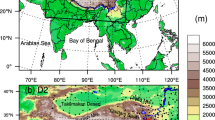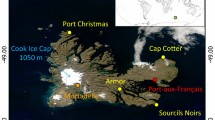Abstract
Six and 21 kyear BP represent the extreme states of climate since the last glacial maximum. The early Holocene, in contrast, was a time of transition, experiencing rapidly melting continental ice sheets, rising sea-level, and increasing summer insolation. Key features of the climate, illustrated by an NCAR CCM3 general circulation model experiment representing 11 kyr BP, include enhanced continentality and seasonality, and an enhanced northern monsoon. The principal circulation responses to the 11 kyr BP boundary conditions can be summarized as an intensification and northward shift of the mean meridional circulation and an intensification of the planetary wave structure of the Northern Hemisphere in northern summer, and a slight intensification of the mean meridional circulation coupled with a southward shift in the planetary wave structure in northern winter. These changes are manifest in the enhancement of the typical seasonal cycle of sea-level pressure in the Northern Hemisphere relative to that of the present day, and enhancement and equatorward shift of the Aleutian and Icelandic lows in northern winter. Over the period 15-8 kyr BP, within the current boreal forest zone, herbaceous tundra was replaced by shrub tundra, and subsequently by evergreen or deciduous forest, but there is uncertainty in the location, timing, and exact nature of these transitions. The specific location of the relatively small area of the Asian boreal forest-tundra transition can have an impact on regional climate, primarily in the net shortwave radiation component of the surface energy budget in spring, and in the cloudiness, net shortwave radiation, and turbulent heat fluxes in summer. These changes also have an impact on global climate. Our results suggest that the additional northern heating leads to a reduced equator-pole heat transport in the Northern Hemisphere which then influences heat and momentum transport in the Southern Hemisphere.











Similar content being viewed by others
References
Anderson PM, Brubaker LB (1994) Vegetation history of northcentral Alaska – a mapped summary of late-quaternary pollen data. Quat Sci Rev 13: 71–92
Bartlein PJ, Anderson PM, Edwards ME, McDowell PF (1991) A framework for interpreting paleoclimatic variations in eastern Beringia. Quat Int 10–12: 73–83
Berger AL (1979) Long-term variations of daily insolation and quaternary climatic changes. J Atmos Sci 35: 2362–2367
Briegleb BP (1992) Delta-Eddington approximation for solar radiation in the NCAR Community Climate Model. J Geophys Res 97: 7603–7612
Briegleb BP, Bromwich D (1998a) Polar radiation budgets of the NCAR CCM3. J Clim 11: 1246–1268
Briegleb BP, Bromwich D (1998b) Polar climate simulation of the NCAR CCM3. J Clim 11: 1270–1286
Bonan GB (1996) A land surface model (LSM version 1.0) for ecological, hydrological, and atmospheric studies: technical description and user's guide. NCAR/TN-417+STR, 150 pp. (Available from NCAR, Boulder, CO 80307)
Bonan GB (2001) Observational evidence for reduction of daily maximum temperature by croplands in the Midwest United States. J Clim 14: 2430–2442
Bonan GB, Chapin FS III, Thompson SL (1995) Boreal forest and tundra ecosystems as components of the climate system. Clim Change 29: 145–167
Burn CR (1997) Cryostratigraphy, paleogeography, and climate change during the early Holocene warm interval, western Arctic coast, Canada. Can J Earth Sci 34: 912–925
Caseldine C (2001) Changes in Betula in the Holocene record from Iceland – a palaeoclimatic record or evidence for early Holocene hybridisation? Rev Palaobot Palynol 117: 139–152
Chapin FS III, Eugster W, McFadden JP, Lynch AH, Walker DA (2000) Regional climate forcing: summer differences among arctic ecosystems. J Clim 13: 2002–2010
Chase TN, Pielke RA, Kittel TGF, Nemani RR, Running SW (2000) Simulated impacts of historical land cover changes on global climate in northern winter. Clim Dyn 16: 93–105
Delire C, Behling P, Coe MT, Foley JA, Jacob R, Kutzbach J, Liu ZY, Vavrus S (2001) Simulated response of the atmosphere–ocean system to deforestation in the Indonesian Archipelago. Geophys Res Lett 28: 2081–2084
de Noblet-Ducoudré N, Claussen M, Prentice C (2000) Mid-Holocene greening of the Sahara: first results of the GAIM 6000 year BP Experiment with two asynchronously coupled atmosphere/ biome models. Clim Dyn 16: 643–659
Diffenbaugh NS, Sloan LC (2002) Global climate sensivity to land surface change: the Mid Holocene revisited. Geophys Res Lett 29: 10.1029/2002GL014880
Doherty R, Kutzbach J, Foley J, Pollard D (2000) Fully coupled climate/dynamical vegetation model simulations over Northern Africa during the mid-Holocene. Clim Dyn 16: 561–573
Edwards ME, Brigham-Grette J (1990) Climatic change and thaw lake formation in Alaska. 11th AMQUA Meeting Abstr p17. Waterloo, Ontario, Canada
Edwards, ME, Mock C, Finney BP, Barber V, Bartlein PJ (2001) Potential analogues for paleoclimatic variations in eastern interior Alaska for the past 14,000 years: atmospheric-circulation controls of regional temperature and moisture responses. Quat Sci Rev 20: 189–202
Elias SA, Short SK, Birks HH (1997) Late Wisconsin environments of the Bering Land Bridge. Palaeogeogn Palaeoclimatol Palaeoecol 136: 293–308
Foley JA, Kutzbach JE, Coe MT, Levis S (1994) Feedbacks between climate and boreal forests during the Holocene epoch. Nature 371: 52–54
Foley JA, Levis S, Prentice IC, Pollard D, Thompson SL (1998) Coupling dynamic models of climate and vegetation. Glob Chem Biol 4: 561–579
Foley JA, Levis S, Costa MH, Cramer W, Pollard D (2000) Incorporating dynamic vegetation cover within global climate models. Ecol App 10: 1620–1632
Hack JJ (1994) Parametrization of moist convection in the National Center for Atmospheric Research Community Climate Model (CCM2). J Geophys Res 99: 5551–5568
Hack JJ, Kiehl JT, Hurrell JW (1998) The hydrologic and thermodynamic characteristics of the NCAR CCM3. J Clim 11: 1179–1206
Harrison SP (1989) Lake levels and climatic change in eastern North America. Clim Dyn 3: 157–167
Harrison SP, Yu G, Tarasov PE (1996) Late quaternary lake-level record from northern Eurasia. Quat Res 45: 138–159
Heck P, Luthi D, Wernli H, Schar C (2001) Climate impacts of European-scale anthropogenic vegetation changes: a sensitivity study using a regional climate model. J Geophys Res 106: 7817–7835
Holslag AA, Boville BA (1993) Local versus nonlocal boundary-layer diffusion in a global climate model. J Clim 6: 1825–1842
Huntley B (1990) European vegetation history: palaeovegetation maps from pollen data – 13,000 yr BP to present. J Quat Sci 5: 103–122
Hurrell JW, Hack JJ, Boville BA, Williamson DL, Kiehl JT (1998) The dynamical simulation of the NCAR Community Climate Model Version 3 (CCM3). J Clim 11: 1207–1236
Indermuhle A, Stocker TF, Joos F, Fischer H, Smith HJ, Wahlen M, Deck B, Mastroianni D, Tschumi J, Blunier T, Meyer R, Stauffer B (1999) Holocene Carbon-Cycle Dynamics based on CO2 trapped in ice at Taylor Dome, Antaractica. Nature 398: 121–126
Joussaume S, Taylor KE, Braconnot P, Mitchell JFB, Kutzbach JE, Harrison SP, Prentice IC, Broccoli AJ, Abe-Ouchi A, Bartlein PJ, Bonfils C, Dong B, Guiot J, Herterich K, Hewitt CD, Jolly D, Kim JW, Kislov A, Kitoh A, Loutre MF, Masson V, McAvaney B, McFarlane N, de Noblet N, Peltier WR, Peterschmitt JY, Pollard D, Rind D, Royer JF, Schlesinger ME, Syktus J, Thompson S, Valdes P, Vettoretti G, Webb RS, Wyputta U (1999) Monsoon changes for 6000 years ago: results of 18 simulations from the Paleoclimate Modeling Intercomparison Project (PMIP). Geophys Res Lett 26: 859–862
Kiehl JT, Hack JJ, Bonan GB, Boville BA, Williamson DL, Rasch PJ (1998) The National Center for Atmospheric Research Community Climate Model: CCM3. J Clim 11: 1131–1149
Kohfeld KE, Harrison SP (2000) How well can we simulate past climates? Evaluating the models using global palaeoenvironmental datasets. Quat Sci Rev 19: 321–346
Kutzbach J, Gallimore R, Harrison S, Behling P, Selin R, Laarif F (1998) Climate and Biome simulations for the past 21,000 years. Quat Sci Rev 17: 473–506
Kullman L (2001) Immigration of Picea abies into North-Central Sweden. New evidence of regional expansion and tree-limit evolution. Nordic J Bot 21: 39–54
Levis S, Foley JA, Pollard D (1999a, b) CO2, climate, and vegetation feedbacks at the Last Glacial Maximum. J Geophys Res 104: 31,191–31,198
Levis S, Foley JA, Brovkin V, Pollard D (1999b) On the stability of the high-latitude climate-vegetation system in a coupled atmosphere–biosphere model. Glob Ecol Biogeogn 8: 489–500
Lozhkin AV, Anderson PM, Eisner WR, Ravako LG, Hopkins DM, Brubaker LB, Colinvaux PA, Miller MC (1993) Late Quaternary lacustrine pollen records from southwestern Beringia. Quat Res 39: 314–324
Lozhkin AV, Anderson PM, Vartanyan SL, Brown TA, Belaya BV, Kotov AN (2001) Late Quaternary paleoenvironments and modern pollen data from Wrangel Island (Northern Chukotka). Quat Sci Rev 20: 217–233
Lynch AH, McGinnis DL, Bailey DA (1998) Snow-albedo feedback and the spring transition in a regional climate system model: influence of land surface model. J Geophys Res 103: 29,037–29,049
Overpeck J, Hughen K, Hardy D, Bradley R, Case R, Douglas M, Finney B, Gajewski K, Jacoby G, Jennings A, Lamoureux S, Lasca A, MacDonald G, Moore J, Retelle M, Smith S, Wolfe A, Zielinski G (1997) Arctic environmental change of the last four centuries. Science 278: 1251–1256
Peltier WR (1994) Ice Age paleotopography. Science 265: 195–201
Pielke RA (2002) Overlooked issues in the US National climate and IPCC assessments. Clim Change 52: 1–11
Potter CS, Wang SS, Nikolov NT, McGuire AD, Liu J, King AW, Kimball JS, Grant RF, Frolking SE, Clein JS, Chen JM, Amthor JS (2001) Comparison of boreal ecosystem model sensitivity to variability in climate and forest site parameters. J Geophys Res 106: 33,671–33,687
Prentice IC, Webb T (1998) BIOME 6000: reconstructing global mid-Holocene vegetation patterns from palaeoecological records. J Biogeogn 25: 997–1005
Prentice IC, Jolly D (2000) Mid-Holocene and glacial-maximum vegetation geography of the northern continents and Africa. J Biogeogn 27: 507–519
Renssen H, Isarin RFB (2001) The two major warming phases of the last deglaciation at 14.7 and 11.5 ka cal BP in Europe: climate reconstructions and AGCM experiments. Global Planet Chem 30: 117–153
Shea DJ, Trenberth KE, Reynolds RW (1992) A global monthly sea surface temperature Climatology. J Clim 5: 987–1001
Shuman B, Webb T III, Bartlein P, Williams JW (2002) The anatomy of a climatic oscillation: vegetation change in eastern North America during the Younger Dryas chronozone. Quat Sci Rev 21: 1777–1791
Snowball I, Zillen L, Gaillard MJ (2002) Rapid early-Holocene environmental changes in northern Sweden based on studies of two varved lake-sediment sequences. Holocene 12: 7–16
Sturm M, McFadden JP, Liston GE, Chapin FS, Racine CH, Holmgren J (2001) Snow-shrub interactions in Arctic tundra: a hypothesis with climatic implications. J Clim 14: 336–344
TEMPO (1996) Potential role of vegetation feedback in the climate sensitivity of high-latitude regions: a case study at 6000 years BP. Glob Biogeochem Cycles 10: 727–736
Thomas G, Rowntree PR (1992) The boreal forests and climate. Q J R Meteorol Soc 118: 469–497
Webb T III, Bartlein PJ, Harrison SP, Anderson KH (1993) Vegetation, lake-levels and climate in Eastern North America. In: Wright HE Jr and others (eds) Global climates since the last glacial maximum. University of Minnesota Press, pp 415–467
Williams JW, Shuman BW, Webb T (2001) Dissimilarity analyses of late-Quaternary vegetation and climate in eastern North America. Ecology 82: 3346–3362
Zhao M, Pitman AJ, Chase T (2001a) The impact of land cover change on the atmospheric circulation. Clim Dyn 17: 467–477
Zhao M, Pitman AJ, Chase TN (2001b) Climatic effects of land cover change at different carbon dioxide levels. Clim Res 17: 1–18
Zhang GJ, McFarlane NA (1995) Sensitivity of climate simulations for the parametrization of cumulus convection in the Canadian Climate Centre general circulation model. Atmosphere–Ocean 33: 407–446
Acknowledgements.
Acknowledgement is made to two anonymous reviewers, and to the National Center for Atmospheric Research, which is sponsored by the National Science Foundation, for the computing time used in this research. This work was further supported by NSF through grants OPP0001476, OPP0001643 and ATM0001643.
Author information
Authors and Affiliations
Corresponding author
Rights and permissions
About this article
Cite this article
Lynch, A.H., Rivers, A.R. & Bartlein, P.J. An assessment of the influence of land cover uncertainties on the simulation of global climate in the early Holocene. Climate Dynamics 21, 243–256 (2003). https://doi.org/10.1007/s00382-003-0331-7
Received:
Accepted:
Published:
Issue Date:
DOI: https://doi.org/10.1007/s00382-003-0331-7




